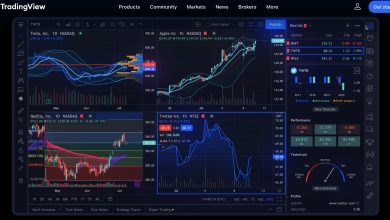Margin Trading: Risks and Rewards

- Understanding Margin Trading
- The Pros and Cons of Margin Trading
- How to Manage Risks in Margin Trading
- Maximizing Profits through Margin Trading
- Common Mistakes to Avoid in Margin Trading
- Regulations and Guidelines for Margin Trading
Understanding Margin Trading
Margin trading is a practice that involves borrowing funds to increase the size of a trade, allowing investors to potentially amplify their gains. However, it also comes with significant risks that can lead to substantial losses if the market moves against them. It is important for traders to have a clear understanding of how margin trading works before engaging in this strategy.
When traders engage in margin trading, they are essentially using leverage to increase their buying power. This means that they can control a larger position than what they would be able to with their own capital alone. While this can lead to higher profits if the trade is successful, it also exposes traders to higher levels of risk.
One of the key concepts to understand in margin trading is the concept of a margin call. A margin call occurs when the value of the assets in a trader’s account falls below a certain threshold, at which point the broker may require the trader to deposit additional funds to cover the losses. Failure to meet a margin call can result in the broker liquidating the trader’s position to cover the losses.
The Pros and Cons of Margin Trading
Margin trading can be a powerful tool for investors looking to maximize their returns, but it also comes with its own set of risks and drawbacks. It’s important to weigh the pros and cons carefully before deciding whether or not to engage in margin trading.
- Pros:
- Increased buying power: Margin trading allows investors to leverage their existing capital to increase their buying power and potentially earn higher returns.
- Short selling: Margin trading also enables investors to profit from the decline in the value of an asset by short selling, which can be a valuable strategy in a bear market.
- Diversification: Margin trading can help investors diversify their portfolios by allowing them to invest in a wider range of assets than they would be able to with cash alone.
- Cons:
- Risk of margin calls: One of the biggest risks of margin trading is the potential for a margin call, where the broker demands additional funds to cover losses in the account. Failure to meet a margin call can result in the liquidation of assets at a loss.
- Increased volatility: Margin trading can amplify both gains and losses, leading to increased volatility in an investor’s portfolio.
- Interest costs: Borrowing funds to trade on margin incurs interest costs, which can eat into profits and potentially outweigh any gains made through leverage.
Ultimately, margin trading can be a useful tool for experienced investors who understand the risks involved and have a solid risk management strategy in place. However, for novice investors or those with a low tolerance for risk, margin trading may not be the best option. It’s important to carefully consider the pros and cons before diving into the world of margin trading.
How to Manage Risks in Margin Trading
Managing risks in margin trading is crucial to protect your investments and avoid significant losses. Here are some strategies to help you navigate the risks associated with margin trading:
- Diversification: One way to manage risks in margin trading is to diversify your investments. By spreading your funds across different assets, you can reduce the impact of a single investment performing poorly.
- Setting Stop-Loss Orders: Implementing stop-loss orders can help limit your losses by automatically selling a security when it reaches a certain price. This can prevent you from losing more money than you are willing to risk.
- Monitoring Market Trends: Keeping a close eye on market trends and news can help you make informed decisions about your margin trades. Being aware of potential risks and opportunities can help you adjust your strategy accordingly.
- Staying Informed: Educating yourself about margin trading and the associated risks is essential. Understanding how margin accounts work, the risks involved, and how to manage them can help you make more informed decisions.
- Consulting with a Financial Advisor: If you are new to margin trading or unsure about how to manage risks effectively, consider seeking advice from a financial advisor. They can provide personalized guidance based on your financial goals and risk tolerance.
By implementing these strategies and staying informed about the risks involved in margin trading, you can better protect your investments and increase your chances of success in the market.
Maximizing Profits through Margin Trading
Margin trading can be a powerful tool for investors looking to maximize their profits in the financial markets. By borrowing funds from a broker to buy more assets than they could with their own capital alone, traders can potentially increase their returns. However, it is essential to understand the risks involved in margin trading and to use this strategy judiciously.
One of the key ways to maximize profits through margin trading is by leveraging your positions. By using borrowed funds to increase the size of your trades, you can amplify your gains when the market moves in your favor. This can lead to higher returns than if you were only trading with your own capital. However, it is crucial to remember that leverage works both ways, and losses can also be magnified in the same manner.
Another way to maximize profits through margin trading is by carefully managing your risk. Setting stop-loss orders and monitoring your positions closely can help you minimize potential losses and protect your capital. By implementing risk management strategies, you can ensure that you are not wiped out by a single bad trade and can continue to trade another day.
It is also essential to conduct thorough research and analysis before entering into any margin trade. Understanding the market conditions, the assets you are trading, and the factors that can impact their prices is crucial for making informed decisions. By staying informed and up-to-date on market trends, you can increase your chances of success in margin trading.
In conclusion, while margin trading can offer the potential for higher profits, it also comes with significant risks. By leveraging your positions, managing your risk effectively, and conducting thorough research, you can maximize your profits and minimize potential losses in margin trading. Remember to trade responsibly and only risk what you can afford to lose.
Common Mistakes to Avoid in Margin Trading
When engaging in margin trading, it is crucial to be aware of common mistakes that can lead to significant financial losses. By avoiding these pitfalls, investors can better navigate the risks and rewards associated with leveraging their investments.
- Overleveraging: One of the most common mistakes in margin trading is overleveraging, or borrowing more funds than one can afford to repay. This can amplify both gains and losses, leading to a higher level of risk.
- Ignoring Margin Calls: Another mistake to avoid is ignoring margin calls. When the value of your investments falls below a certain threshold, brokers may issue a margin call requiring you to deposit additional funds to cover potential losses. Failure to meet margin calls can result in the forced liquidation of your assets.
- Not Setting Stop-Loss Orders: Failing to set stop-loss orders is a common error that can expose investors to unlimited losses. Stop-loss orders automatically sell a security when it reaches a predetermined price, helping to limit potential losses.
- Trading Without a Plan: Engaging in margin trading without a well-defined plan is a recipe for disaster. It is essential to establish clear investment goals, risk tolerance levels, and exit strategies before entering into leveraged positions.
- Chasing Losses: Trying to recover losses by taking on more risk can lead to a downward spiral. It is crucial to accept losses as part of trading and avoid emotional decision-making based on past performance.
By being mindful of these common mistakes and implementing sound risk management strategies, investors can enhance their chances of success in margin trading. It is essential to approach leveraged trading with caution and discipline to mitigate potential risks and maximize potential rewards.
Regulations and Guidelines for Margin Trading
When engaging in margin trading, it is crucial to adhere to regulations and guidelines to mitigate risks and maximize rewards. These rules are put in place to protect investors and ensure the stability of the financial markets.
One key regulation to follow is maintaining a minimum margin requirement, which is the amount of equity that must be held in a margin account. This helps prevent investors from overleveraging themselves and facing margin calls.
Additionally, it is important to be aware of the rules regarding margin maintenance. If the value of securities in a margin account falls below a certain threshold, investors may be required to deposit more funds to meet the maintenance margin.
Furthermore, understanding the guidelines for margin trading is essential for making informed investment decisions. Investors should carefully assess their risk tolerance and financial goals before engaging in margin trading to avoid potential losses.
By following the regulations and guidelines for margin trading, investors can navigate the complexities of the market with confidence and increase their chances of success.





